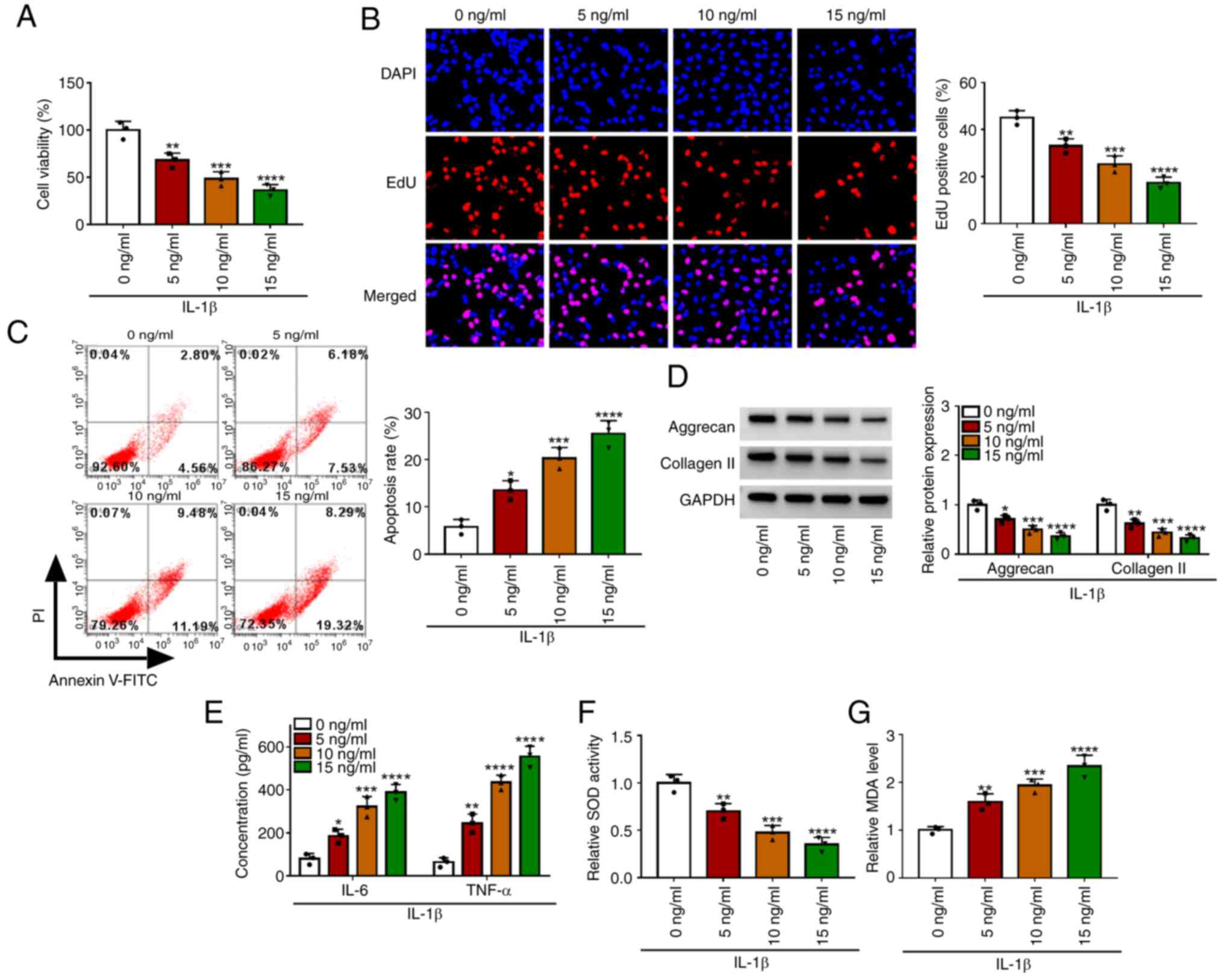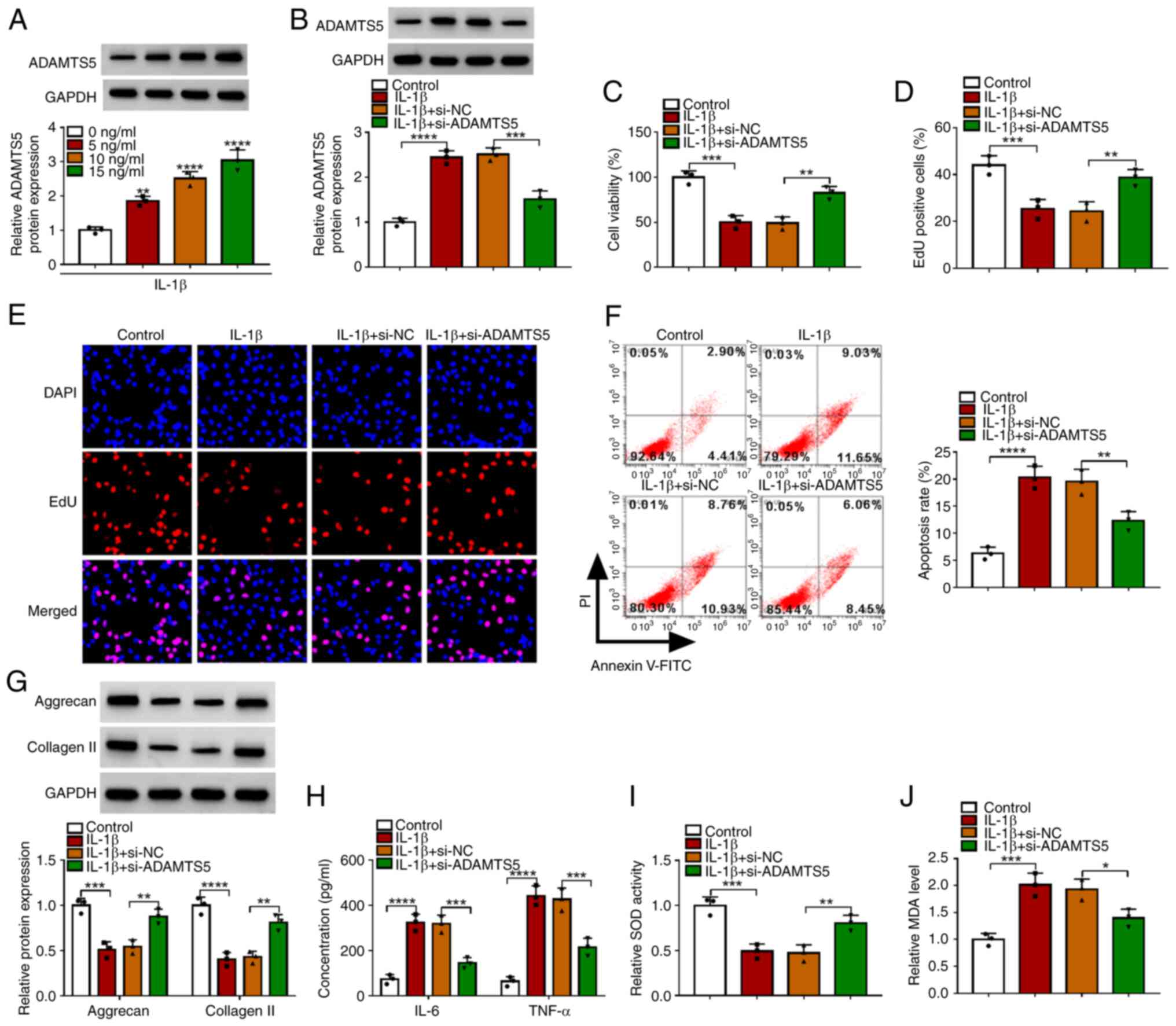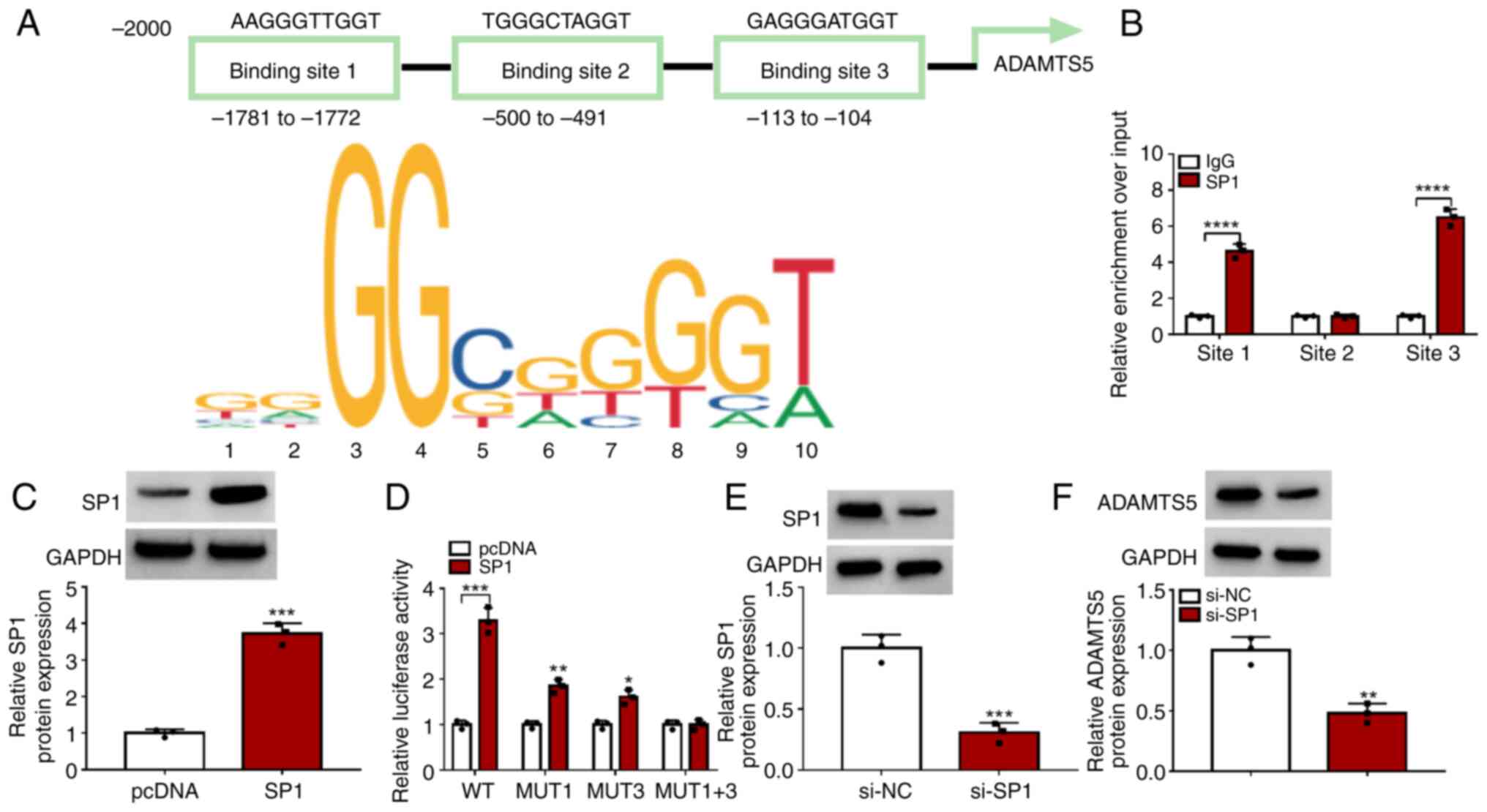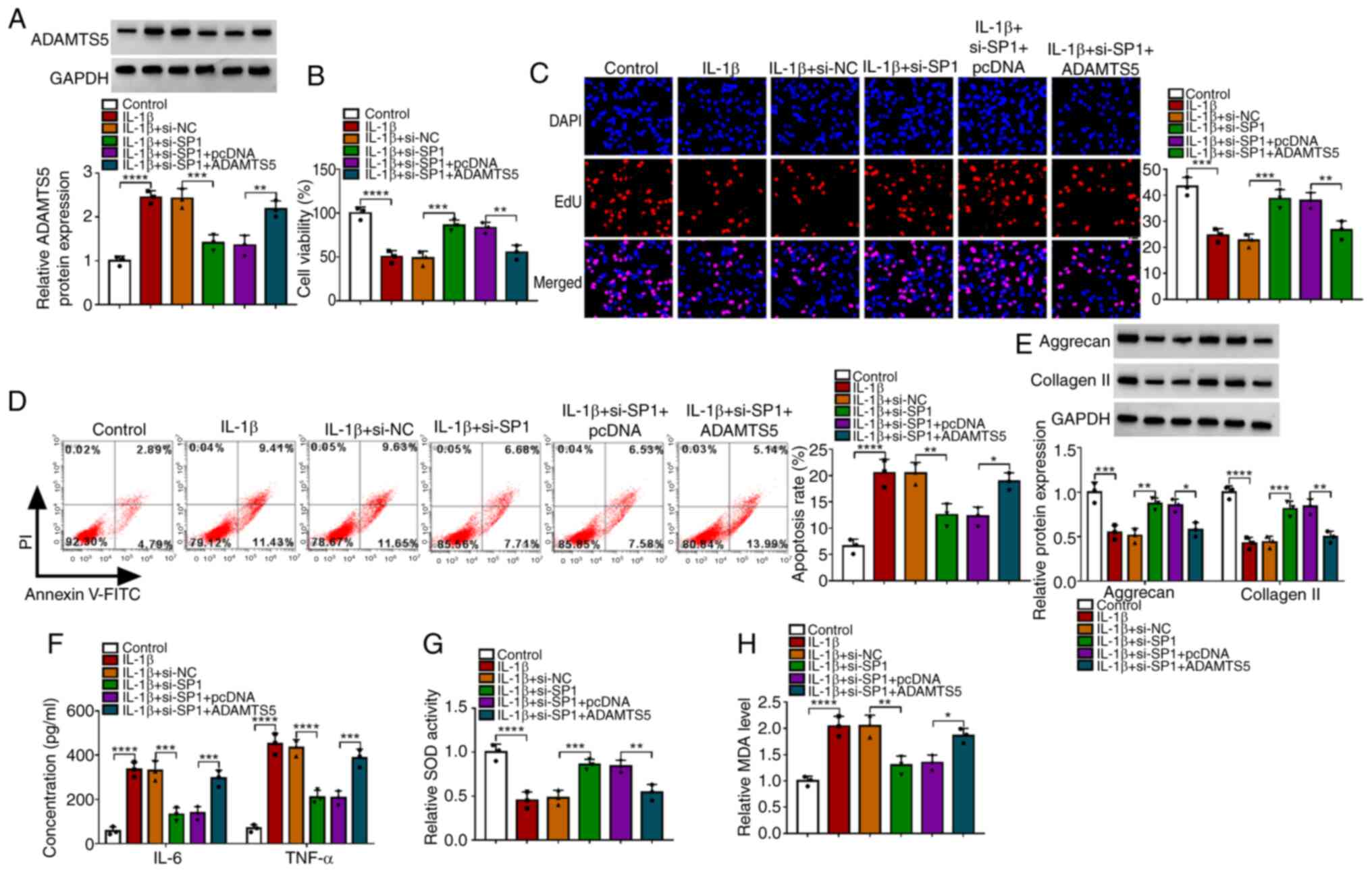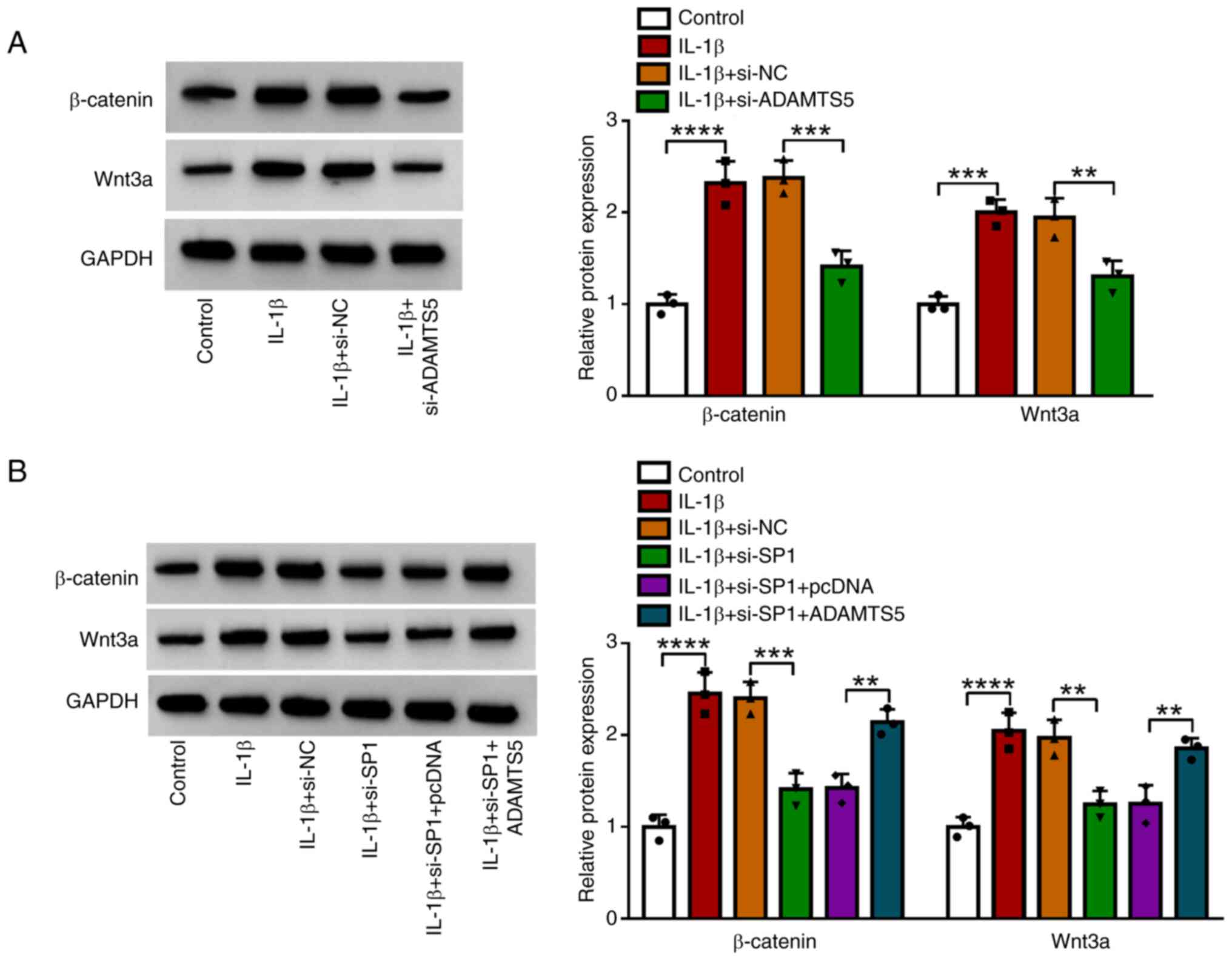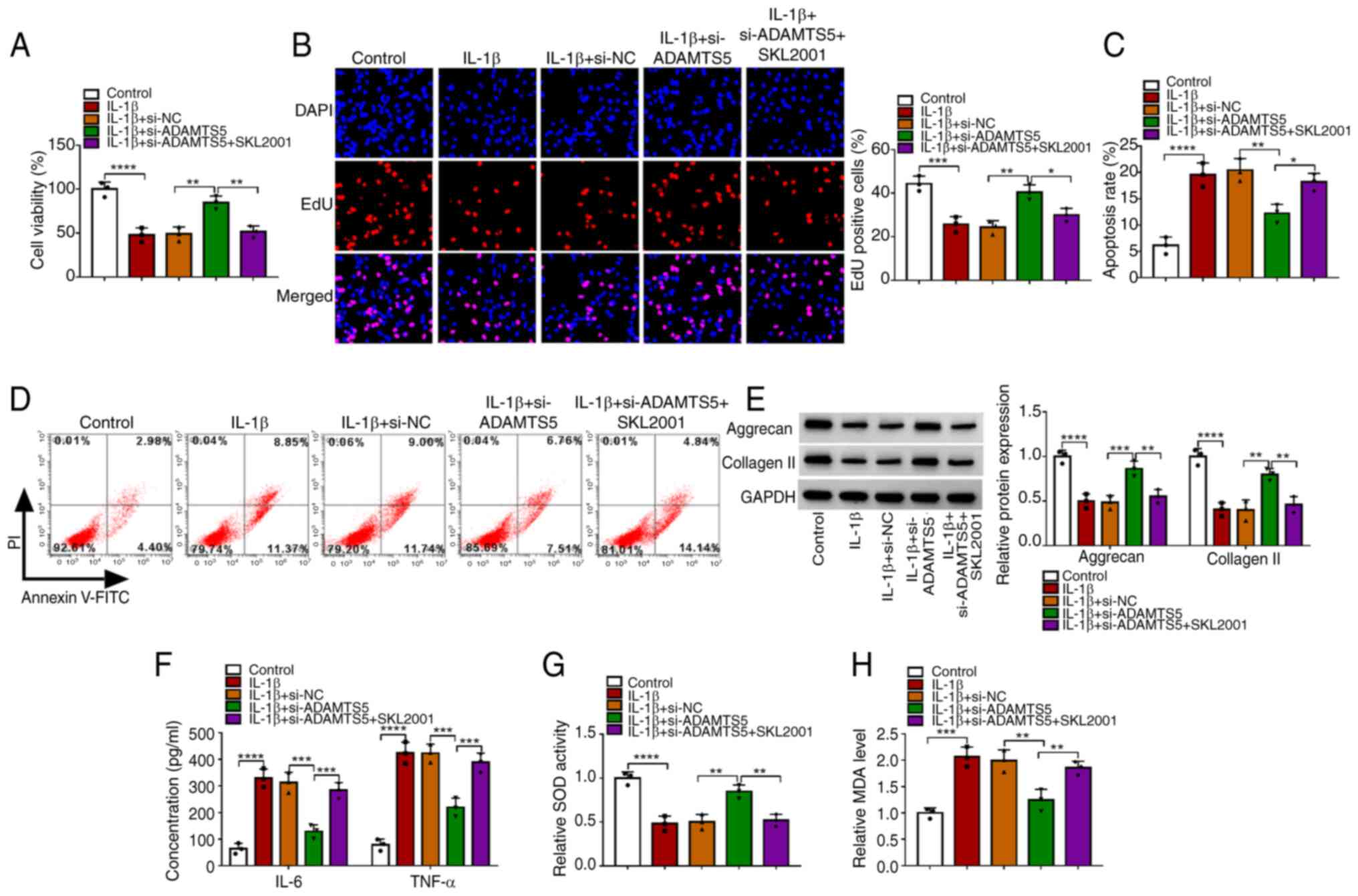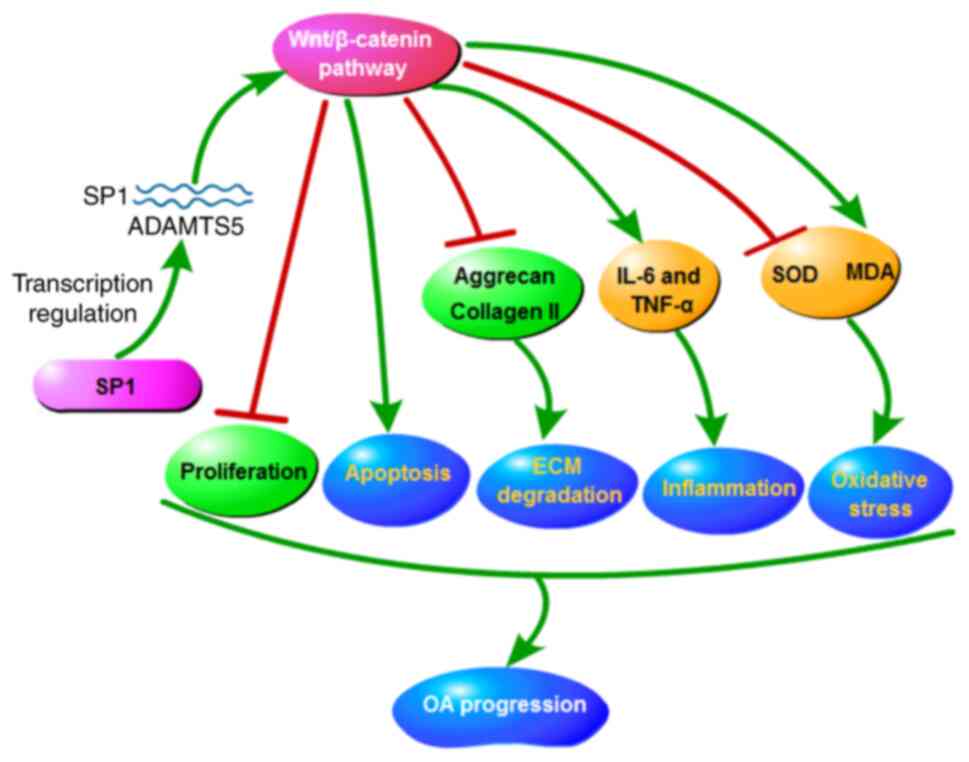SP1‑mediated ADAMTS5 transcription promotes IL‑1β‑induced chondrocyte injury via Wnt/β‑catenin pathway in osteoarthritis
- Authors:
- Published online on: June 26, 2024 https://doi.org/10.3892/mmr.2024.13273
- Article Number: 149
-
Copyright: © Hao et al. This is an open access article distributed under the terms of Creative Commons Attribution License.
Abstract
Introduction
Osteoarthritis (OA) is a type of chronic joint disease characterized by degenerative degeneration of articular cartilage (1,2). Chondrocytes are the only cells found in articular cartilage and play a key role in maintaining the stability of cartilage tissues (3,4). The apoptosis, inflammation, extracellular matrix (ECM) degradation and oxidative stress of chondrocytes contribute to the development of articular cartilage disease (5,6). Interleukin-1β (IL-1β), a major pro-inflammatory factor, is associated with the pathogenesis of OA and is often used to simulate the OA cell model in vitro (7,8). Therefore, exploring the molecular mechanisms regulating IL-1β-induced chondrocyte injury is helpful to provide potential targets for OA treatment.
The ADAMTS5 gene encodes a protein belonging to the ADAMTS protein family, which acts as an aggrecanase to cleave aggrecan, thereby mediating cartilage injury in OA (9,10). Furthermore, studies have shown that ADAMTS5 is a major aggrecanase leading to cartilage degradation in the development of OA, which is positively associated with the degree of articular cartilage degradation (11,12). Notably, ADAMTS5 had been confirmed to promote ECM degradation, inflammation and apoptosis in IL-1β-induced chondrocytes (13–15). Therefore, ADAMTS5 is a key regulator of the OA process, and its molecular mechanisms are worth further investigation. The Wnt/β-catenin pathway plays a vital function in chondrogenesis and has been confirmed to be related to the occurrence of OA (16,17). However, it is unclear whether ADAMTS5 mediates OA progression by regulating the Wnt/β-catenin pathway.
The transcription factor, specific protein 1 (SP1) belongs to the specificity protein/Kruppel-like factors family and is a sequence-specific DNA-binding protein that regulates the transcription process of gene promoters (18). SP1 has been found to be involved in numerous pathological processes and plays an important role in cell growth and tumorigenesis (19,20). For example, it has been reported that SP1 accelerates apoptosis, ECM degradation and inflammation in IL-1β-induced chondrocytes (21). Furthermore, a previous study indicated that SP1 could bind to the acyl-CoA synthetase long-chain family member 4 (Acsl4) promoter region to increase Acsl4 expression, thereby accelerating IL-1β-induced chondrocyte oxidative stress and ferroptosis (22). It was hypothesized that SP1 binds to the ADAMTS5 promoter region through bioinformatics prediction (Jaspar software), but whether SP1 regulates the transcription of ADAMTS5 to mediate OA process is unclear.
Therefore, the present study investigated the hypothesis that SP1 might mediate ADAMTS5 transcription, thereby regulating IL-1β-induced chondrocyte injury via the Wnt/β-catenin pathway.
Materials and methods
Cell culture, treatment and transfection
Human chondrocytes (CHON-001; American Type Culture Collection) were cultured in DMEM containing 0.1 mg/ml geneticin (G-418; Gibco; Thermo Fisher Scientific, Inc.) and 10% FBS (Gibco; Thermo Fisher Scientific, Inc.) at 37°C with 5% CO2. CHON-001 cells were stimulated with different concentrations (0, 5, 10 and 15 ng/ml) of IL-1β at 37°C for 24 h to establish the OA cell model. For transfection, cells were transfected with 50 nM ADAMTS5 siRNA [si-ADAMTS5, forward (F) 5′-AAAAUGUUUGGAUUCGUGCUC-3′; reverse (R) 5′-GCACGAAUCCAAACAUUUUCC-3′], 50 nM SP1 siRNA (si-SP1, F 5′-ACUUGAUACUGAAUAUUAGGC-3′; R 5′-CUAAUAUUCAGUAUCAAGUAA-3′), 4.0 µg pcDNA3.1 ADAMTS5 overexpression vector (F 5′-AAAGGGGAGAATCTGCCTGC-3′; R 5′-CCAAGATCCCCAGTTGCCAT-3′), 4.0 µg pcDNA3.1 SP1 overexpression vector (F 5′-GTCCGCCCTCTGACCAAG-3′; R 5′-AAGGCACCACCACCATTACC-3′) or negative controls (si-NC, F 5′-GGAGUAGGGAGCAAACCUAUAGGAA-3′, R 5′-UUCCUAUAGGUUUGCUCCCUACUCC-3′; pcDNA3.1, F 5′-CTAGAGAACCCACTGCTTAC-3′, R 5′-TAGAAGGCACAGTCGAGG-3′) using Lipofectamine® 2000 (Invitrogen; Thermo Fisher Scientific, Inc.) at 37°C for 24 h. All siRNAs and pcDNAs were purchased from Guangzhou RiboBio Co., Ltd. After 24 h post-transfection, cells were treated with 10 ng/ml IL-1β for 24 h at 37°C. To explore the role of Wnt/β-catenin pathway in the regulation of ADAMTS5 on IL-1β-induced CHON-001 cell injury, CHON-001 cells were transfected with 50 nM si-NC/si-ADAMTS5 for 24 h and treated with 10 ng/ml IL-1β and 40 µM Wnt/β-catenin pathway agonist SKL2001 (MedChemExpress, Inc.) for 24 h at 37°C.
Isolation of primary chondrocytes
Fresh articular cartilages were collected from 6 patients (aged 36–49 years; male/female, 3/3) with femoral neck fractures (underwent total hip replacement surgery) at Xiangyang NO.1 People's Hospital, Hubei University of Medicine (Xiangyang, China) between August 2020 and March 2021. All patients provided written informed consent at the time of the present study and agreed to the use of their samples in scientific research. Cartilages were cut into 1-mm3 slices and were digested with 4 mg/ml protease and 0.25 mg/ml collagenase P. After centrifugation (2,000 × g for 5 min at room temperature), cell pellets were cultured in DMEM/F12 medium (Gibco; Thermo Fisher Scientific, Inc.) containing 5% FBS and 1% penicillin/streptomycin at 37°C with 5% CO2. To further confirm that the SP1/ADAMTS5 axis regulated IL-1β-induced chondrocyte injury, primary chondrocytes were transfected with si-NC/si-SP1/pcDNA/ADAMTS5 and then treated with 10 ng/ml IL-1β for 24 h at 37°C. The conditions for these transfections in primary chondrocytes were the same as the transfections with CHON-001 cells. The present study was approved by The Ethics Committee of Xiangyang NO.1 People's Hospital, Hubei University of Medicine (Xiangyang, China; approval no. XYYYE20200082).
MTT assay
Cells were inoculated into 96-well plates (2,000 cells/well) and cultured for 24 h at 37°C. After which, cells were treated with MTT solution (Beyotime Institute of Biotechnology) for 4 h. Following MTT incubation, the formazan was dissolved using formazan dissolving solution (Beyotime Institute of Biotechnology). The absorbance was measured at 570 nm to detect cell viability.
EdU assay
CHON-001 cells in 96-well plates were stained with EdU solution and DAPI solution using the EdU Image Kit (Guangzhou RiboBio Co., Ltd.), according to the manufacturer's instructions. Images were captured under a fluorescent microscope (magnification, 200×) to measure the EdU-positive cell rate using ImageJ software (version 1.8.0; National Institutes of Health).
Flow cytometry
CHON-001 cells and primary chondrocytes (1×104 cells) were suspended with binding buffer and then stained with Annexin V-FITC and PI using the Annexin V-FITC Apoptosis Detection Kit (Beyotime Institute of Biotechnology). The apoptosis rate of cells was analyzed by flow cytometry (FACScalibur; BD Biosciences) with CellQuest Pro software (version 3.3, BD Biosciences).
Western blotting
Protein samples were collected from CHON-001 cells and primary chondrocytes using RIPA lysis buffer (Beyotime Institute of Biotechnology) and quantified by BCA Kit (Beyotime Institute of Biotechnology). The protein samples (30 µg) were separated by 10% SDS-PAGE gel and then imprinted on a PVDF membrane. The membrane was blocked with 5% skimmed milk at 4°C for 2 h and incubated with the following primary antibodies (all Abcam): Anti-Aggrecan (1:1,000; cat. no. ab36861), anti-Collagen II (1:1,000; cat. no. ab34712), anti-ADAMTS5 (1:250; cat. no. ab41037), anti-SP1 (1:10,000; cat. no. ab227383), anti-Wnt3a (1:1,000; cat. no. ab28472), anti-β-catenin (1:4,000; cat. no. ab16051) and anti-GAPDH (1:2,500; cat. no. ab9485) at 4°C overnight. After which, the membranes was incubated with the secondary antibody at room temperature for 1 h, goat anti-rabbit IgG (1:50,000; cat. no. ab205718; Abcam). Protein signals were detected by ECL reagent and analyzed by ImageJ software (version 1.8.0, National Institutes of Health).
ELISA
The supernatant of CHON-001 cells and primary chondrocytes was collected to assess the concentrations of IL-6 and TNF-α using the Human IL-6 ELISA Kit (cat. no PI325; Beyotime Institute of Biotechnology) and Human TNF-α ELISA Kit (cat. no. PT518; Beyotime Institute of Biotechnology), respectively, according to the manufacturer's instructions.
Detection of oxidative stress
Superoxide dismutase (SOD) activity and malondialdehyde (MDA) levels in cells were determined using the SOD Assay Kit (Beyotime Institute of Biotechnology) and MDA Assay Kit (Beyotime Institute of Biotechnology), according to the manufacturer's instructions.
Reverse transcription-quantitative PCR (RT-qPCR)
A TRIzol® kit (Invitrogen; Thermo Fisher Scientific, Inc.) was used to extract total RNA from CHON-001 cells, and after which, cDNA was generated using a reverse transcription kit (Takara Bio, Inc.) following the conditions: 6 cycles of 37°C for 15 min, 85°C for 5 sec and 7 cycles of 4°C. qPCR was performed using the SYBR Premix Ex Taq Kit (Takara Bio, Inc.) following thermocycling conditions: 95°C for 1 min, 40 cycles of 95°C for 15 sec, 55°C for 30 sec and 72°C for 30 sec. The 2−∆∆Cq method (23) was used for calculating the relative expression of ADAMTS5 with GAPDH as the internal control. The primer sequences are listed in Table I.
Chromatin immunocoprecipitate (ChIP) assay
The binding sites of SP1 in the ADAMTS5 promoter region were predicted using the Jaspar tools (version 2024; http://jaspar.elixir.no/). CHON-001 cells were crosslinked with formaldehyde, and then the cell lysates were ultrasound treated (10 cycles of 25 sec on and 30 sec off; centrifuged 10,000 × g for 10 min at 4°C) to obtain DNA fragments. Next, the cell lysate was incubated with anti-SP1 (1:200; cat. no. ab227383; Abcam) or anti-IgG (1:1,000; cat. no. ab171870; Abcam) at 4°C overnight. The precipitated DNA was collected by protein A/G-agarose beads and then used for RT-qPCR. The conditions were the same as the aforementioned RT-qPCR.
Dual-luciferase reporter assay
The wild-type (WT) and mutant-type (MUT1, MUT3 and MUT1+3) promoter fragments of ADAMTS5 were cloned into the pGL3-basic vector. The 293T cells (American Type Culture Collection) were co-transfected with the pcDNA3.1 SP1 overexpression vector and the aforementioned vectors (WT, MUT1, MUT3 and MUT1+3) using Lipofectamine® 2000 (Invitrogen; Thermo Fisher Scientific, Inc.), and the relative luciferase activity (Firefly luciferase/Renilla luciferase) was detected by Dual-Lucy Detection Assay Kit (Beyotime Institute of Biotechnology) after 48 h.
Statistical analysis
Results are presented as the mean ± SEM. All experiments were performed in triplicate (n=3), with each independent experiment set 3 times to generate an average value. Unpaired student's t-test (for 2 groups) or one-way ANOVA (for multiple groups) followed by Tukey's post-hoc test was used to perform statistical comparisons using GraphPad Prism 7.0 software (Dotmatics). P<0.05 was considered to indicate a statistically significant difference.
Results
IL-1β induces CHON-001 chondrocyte injury
To determine the effect of IL-1β on chondrocyte injury, CHON-001 cells were treated with different concentrations of IL-1β. The results showed that with the increase of IL-1β concentration, cell viability and EdU-positive cell rate were significantly decreased, while cell apoptosis rate was markedly increased (Fig. 1A-C). In addition, with increasing concentrations of IL-1β, the expression of matrix proteins (aggrecan and collagen II) and SOD activity were reduced, while the concentrations of inflammatory factors (IL-6 and TNF-α) and MDA levels were enhanced in a concentration-dependent manner (Fig. 1D-G). The aforementioned data showed that IL-1β could promote apoptosis, ECM degradation, inflammation and oxidative stress to induce chondrocyte injury. In the follow-up function tests, 10 ng/ml IL-1β was used to induce the OA in vitro model.
Knockdown of ADAMTS5 alleviates IL-1β-induced chondrocyte injury
ADAMTS5 expression was detected through western blotting and it was confirmed that ADAMTS5 was gradually enhanced with increasing IL-1β concentration in CHON-001 cells at the protein level (Fig. 2A). To confirm the role of ADAMTS5 in OA progression, the effect of ADAMTS5 knockdown on IL-1β-induced chondrocyte injury was detected. Firstly, the transfection of si-ADAMTS5 was used to reduce ADAMTS5 protein expression in CHON-001 cells (Fig. S1A). The detection of ADAMTS5 expression showed that the promoting effect of IL-1β on ADAMTS5 protein expression was significantly reduced by si-ADAMTS5 (Fig. 2B). ADAMTS5 knockdown enhanced the viability and EdU-positive cell rate of IL-1β-induced CHON-001 cells (Fig. 2C-E). Furthermore, the promoting effect of IL-1β on the apoptosis rate of CHON-001 cells also could be suppressed by ADAMTS5 silencing (Fig. 2F). In addition, downregulation of ADAMTS5 increased the levels of matrix protein (aggrecan and collagen II) and SOD activity, while decreased the concentrations of inflammatory factors (IL-6 and TNF-α) and MDA levels in IL-1β-induced CHON-001 cells (Fig. 2G-J). These data suggested that ADAMTS5 knockdown relieved IL-1β-induced chondrocyte apoptosis, ECM degradation, inflammation and oxidative stress, confirming that ADAMTS5 might promote IL-1β-induced chondrocyte injury to accelerate OA progression.
SP1 activates the transcription of ADAMTS5
The Jaspar software predicted that there were three binding sites between the transcription factor SP1 and ADAMTS5 promoter region (Fig. 3A). ChIP assay results showed that SP1 could bind with the promoter sites 1 and 3 of ADAMTS5 (Fig. 3B). After which, the WT, MUT1, MUT3 and MUT1+3 sequences for promoter site 1 and 3 of ADAMTS5 were constructed, and the SP1 overexpression vector was used to enhance SP1 protein expression in 293T cells (Fig. 3C). Dual-luciferase reporter assay results revealed that SP1 overexpression enhanced the luciferase activity of MUT1 and MUT3 and especially WT vectors, but did not affect the MUT1+3 vector (Fig. 3D). These data confirmed that transcription factor SP1 binds to the promoter region of ADAMTS5. Additionally, si-SP1 was used to reduce SP1 expression in chondrocytes (Fig. 3E). By detecting ADAMTS5 protein levels, it was discovered that SP1 knockdown markedly reduced ADAMTS5 expression (Fig. 3F). These data indicated that the transcription factor SP1 increased ADAMTS5 expression by binding to its promoter region to activate its transcription.
Overexpression of ADAMTS5 reverses the inhibitory effect of SP1 knockdown on IL-1β-induced chondrocyte injury
The ADAMTS5 overexpression vector was used to enhance ADAMTS5 expression in CHON-001 cells (Fig. S1B). To explore whether SP1 regulated ADAMTS5 to mediate OA progression, IL-1β-induced CHON-001 cells were co-transfected with si-SP1 and the ADAMTS5 overexpression vector. The detection of ADAMTS5 protein expression suggested that si-SP1 reduced ADAMTS5 expression in IL-1β-induced CHON-001 cells, and the transfection of ADAMTS5 overexpression vector enhanced ADAMTS5 expression (Fig. 4A). Functional experiments revealed that SP1 knockdown promoted viability, enhanced EdU-positive cell rate and repressed the apoptosis rate in IL-1β-induced CHON-001 cells, while these effects could be reversed by ADAMTS5 overexpression (Fig. 4B-D). Furthermore, SP1 silencing also elevated the levels of matrix proteins (aggrecan and collagen II), reduced the concentrations of inflammatory factors (IL-6 and TNF-α), increased SOD activity and decreased MDA levels in IL-1β-induced CHON-001 cells, while ADAMTS5 overexpression also abolished these effects (Fig. 4E-H). To further confirm this, the related study in IL-1β-induced primary chondrocytes was performed. The transfections of si-SP1 and the ADAMTS5 overexpression vector were used to decrease SP1 protein expression and increase ADAMTS5 protein expression in primary chondrocytes, respectively (Fig. S1C and D). si-SP1 reduced ADAMTS5 protein level in IL-1β-induced primary chondrocytes, while ADAMTS5 overexpression eliminated this effect (Fig. S2A). Furthermore, the knockdown of SP1 increased cell viability and SOD activity, while it reduced the apoptosis rate, and IL-6, TNF-α and MDA levels in IL-1β-induced primary chondrocytes. However, these results also were reversed by ADAMTS5 overexpression (Fig. S2B-G). Notably, these results confirmed that SP1 knockdown alleviated IL-1β-induced chondrocyte injury by decreasing ADAMTS5 expression.
SP1/ADAMTS5 axis promotes the activity of the Wnt/β-catenin pathway
The effect of SP1 and ADAMTS5 on the activity of Wnt/β-catenin pathway was explored by measuring the protein expression of β-catenin and Wnt3a. The data showed that IL-1β treatment increased the protein expression of β-catenin and Wnt3a, and ADAMTS5 knockdown suppressed these levels in IL-1β-induced CHON-001 cells (Fig. 5A). Furthermore, SP1 knockdown reduced the protein expression of β-catenin and Wnt3a in IL-1β-induced CHON-001 cells, and this effect was be eliminated by ADAMTS5 overexpression (Fig. 5B). These data showed that SP1 might regulate ADAMTS5 to promote the activity of the Wnt/β-catenin pathway.
SKL2001 reverses the si-ADAMTS5-mediated inhibitory effect on IL-1β-induced chondrocyte injury
To further confirm the role of the Wnt/β-catenin pathway in the regulation of ADAMTS5 on IL-1β-induced chondrocyte injury, IL-1β-induced CHON-001 cells were transfected with si-ADAMTS5 and treated with the Wnt/β-catenin pathway agonist SKL2001. The data showed that the promoting effect of si-ADAMTS1 on the viability and EdU-positive cell rate, as well as the inhibiting effect on the apoptosis rate of IL-1β-induced CHON-001 cells, could be abolished by SKL2001 (Fig. 6A-D). Furthermore, SKL2001 treatment also eliminated the si-ADAMTS5-mediated increasing effect on the levels of matrix proteins (aggrecan and collagen II) and SOD activity, and the decreasing effect on the concentrations of inflammatory factors (IL-6 and TNF-α) and MDA levels in IL-1β-induced CHON-001 cells (Fig. 6E-H). These data suggested that ADAMTS5 knockdown alleviated IL-1β-induced chondrocyte injury by inhibiting the activity of the Wnt/β-catenin pathway. To conclude, the data showed that SP1/ADAMTS5 suppressed proliferation, while accelerated apoptosis, ECM degradation, inflammation and oxidative stress in IL-1β-induced chondrocytes by promoting the activity of the Wnt/β-catenin pathway, thereby facilitating OA progression (Fig. 7).
Discussion
OA is a common disease and can cause joint pain and stiffness deformity, which heavily impacts human health (24). At present, OA pathogenesis has not been fully elucidated, but abnormal expression of some disease-related genes has been confirmed to be related to OA development (25). Fisch et al (26) found a total of 1,332 differentially expressed genes between OA and non-OA tissues samples by RNA sequencing analysis. Furthermore, Huang et al (27) analyzed the GEO database (dataset no. GSE48556) and noted that there were 1,696 differentially expressed genes in OA samples compared with normal tissues. Studies have shown that ADAMTS5 is under expressed in the normal articular cartilage matrix, but abnormal expression of ECM-related cytokines in OA has led to increased ADAMTS5 expression, which accelerates ECM degradation and cartilage injury (28,29). It has been reported that ADAMTS5 overexpression contributes to the decreased viability and promoted ECM degradation in IL-1β-induced chondrocytes (13). Yu et al (14) reported that ADAMTS5 accelerated IL-1β-treated CHON-001 cell injury, including inflammation and apoptosis. Li et al (15) suggested that ADAMTS5 overexpression enhanced inflammation, apoptosis and ECM degradation in IL-1β-treated chondrocytes. Moreover, ADAMTS5 had elevated expression in OA tissues and its upregulation could induce apoptosis and ECM degradation in IL-1β-treated chondrocytes (30). Consistent with previous studies (13–15,30), the present study used IL-1β to induce chondrocyte apoptosis, ECM degradation and inflammation, and revealed that ADAMTS5 knockdown reversed the inducing effect of IL-1β on chondrocyte injury. In addition, it was also found that ADAMTS5 knockdown inhibited IL-1β-induced chondrocyte oxidative stress. These findings offer new evidence for ADAMTS5 as a potential target for OA therapy.
The transcription factor SP1 has been shown to mediate OA progression through promoting chondrocyte injury (21,22). Notably, SP1 can regulate the expression of genes that have GC-rich promoters, thereby mediating numerous cellular functions, including cell proliferation, apoptosis and differentiation (31). Kong et al (32) reported that SP1 could upregulate the promoter activity of the cancer-associated biomarker CD147, thus mediating lung cancer progression. Furthermore, the transcription factor SP1 might be an effective target for inhibiting disc-related ECM loss, and its inhibitor could reduce ADAMTS5 promoter activity (33). In the present study, it was found that SP1 could bind to the promoter region of ADAMTS5 at −1,781 to −1,772 and −113 to −104 bp to enhance ADAMTS5 expression. Moreover, downregulation of SP1 alleviated IL-1β induced-chondrocyte injury via reducing ADAMTS5 expression, confirming that SP1-mediated ADAMTS5 transcription regulated OA progression. To the best of our knowledge, the present study is the first to reveal the interaction between SP1 and ADAMTS5 in OA progression and indicates that the SP1/ADAMTS5 axis mediates OA progression by regulating the Wnt/β-catenin pathway.
Wnt/β-catenin is a unique pathway that regulates the development of OA and affects OA process by influencing chondrocyte function (34). Studies have shown that the Wnt/β-catenin pathway is overactivated in IL-1β-treated chondrocytes, and inhibition of Wnt/β-catenin activity could significantly relieve chondrocyte injury (35,36). In the present study it was confirmed that IL-1β treatment activated the Wnt/β-catenin pathway, and this effect could be abolished by the silencing of ADAMTS5 and SP1. In the protection of chondrocytes mediated by si-ADAMTS5, activation of the Wnt/β-catenin signal used SKL2001 to alter the inhibitory effect of si-ADAMTS5 on chondrocyte injury. These results further confirmed that ADAMTS5 promoted OA progression by mediating Wnt/β-catenin pathway activity, which provided new evidence for Wnt/β-catenin pathway-mediated chondrocyte injury. However, the present study also had some limitations. At present, only the expression of Wnt3a and β-catenin has been examined, and no data are currently available on the phosphorylation status of β-catenin. Future research will continue to explore the specific proteins regulated by Wnt/β-catenin and reveal its downstream pathways to further improve the experimental results. In addition, studies were only carried out at the cellular level, and no animal experiments have been performed. Future endeavors will consider conducting animal experiments to further confirm the findings of the present study.
To conclude, the present study indicated that ADAMTS5, mediated by the transcription factor SP1, promoted IL-1β-induced chondrocyte injury via activating the Wnt/β-catenin pathway. The proposed SP1/ADAMTS5/Wnt/β-catenin axis provides a new theoretical basis for developing molecular targets of OA therapy.
Supplementary Material
Supporting Data
Acknowledgεments
Not applicable.
Funding
This work was funded by the Xiangyang Medical and Health Field Science and Technology Project (grant no. 2022YL31B).
Availability of data and materials
The data generated in the present study may be requested from the corresponding author.
Authors' contributions
XH collected the data, performed the data analysis and drafted the manuscript; and XW conceived and designed the study, drafted the manuscript and supervised the study. Both authors read approved the final version of the manuscript. XH and XW confirm the authenticity of all the raw data.
Ethics approval and consent to participate
This study was approved by The Ethics Committee of Xiangyang No.1 People's Hospital, Hubei University of Medicine (Xiangyang, China; approval no. XYYYE20200082).
Patient consent for publication
Not applicable.
Competing interests
The authors declare that they have no competing interests.
References
|
Pereira D, Ramos E and Branco J: Osteoarthritis. Acta Med Port. 28:99–106. 2015. View Article : Google Scholar : PubMed/NCBI | |
|
Abramoff B and Caldera FE: Osteoarthritis: Pathology, diagnosis, and treatment options. Med Clin North Am. 104:293–311. 2020. View Article : Google Scholar : PubMed/NCBI | |
|
Schulze-Tanzil G: Activation and dedifferentiation of chondrocytes: Implications in cartilage injury and repair. Ann Anat. 191:325–338. 2009. View Article : Google Scholar : PubMed/NCBI | |
|
Shen H, He Y, Wang N, Fritch MR, Li X, Lin H and Tuan RS: Enhancing the potential of aged human articular chondrocytes for high-quality cartilage regeneration. FASEB J. 35:e214102021. View Article : Google Scholar : PubMed/NCBI | |
|
Mao H, Han B, Li H, Tao Y and Wu W: FABP4 knockdown suppresses inflammation, apoptosis and extracellular matrix degradation in IL-1β-induced chondrocytes by activating PPARγ to regulate the NF-κB signaling pathway. Mol Med Rep. 24:8552021. View Article : Google Scholar : PubMed/NCBI | |
|
Zahan OM, Serban O, Gherman C and Fodor D: The evaluation of oxidative stress in osteoarthritis. Med Pharm Rep. 93:12–22. 2020.PubMed/NCBI | |
|
Jin J, Lv X, Wang B, Ren C, Jiang J, Chen H, Chen X, Gu M, Pan Z, Tian N, et al: Limonin Inhibits IL-1β-induced inflammation and catabolism in chondrocytes and ameliorates osteoarthritis by activating Nrf2. Oxid Med Cell Longev. 2021:72925122021. View Article : Google Scholar : PubMed/NCBI | |
|
Wei J, Gao C, Hu K, Li M, Li J, Shen M and Zhang S: Knockdown of DAPK1 attenuates IL-1β-induced extracellular matrix degradation and inflammatory response in osteoarthritis chondrocytes via regulating the p38 MAPK-signaling pathway. Allergol Immunopathol (Madr). 50:169–175. 2022. View Article : Google Scholar : PubMed/NCBI | |
|
Mead TJ and Apte SS: ADAMTS proteins in human disorders. Matrix Biol. 71–72. 225–239. 2018. | |
|
Li T, Peng J, Li Q, Shu Y, Zhu P and Hao L: The mechanism and role of ADAMTS protein family in osteoarthritis. Biomolecules. 12:9592022. View Article : Google Scholar : PubMed/NCBI | |
|
Chu X, You H, Yuan X, Zhao W, Li W and Guo X: Protective effect of lentivirus-mediated siRNA targeting ADAMTS-5 on cartilage degradation in a rat model of osteoarthritis. Int J Mol Med. 31:1222–1228. 2013. View Article : Google Scholar : PubMed/NCBI | |
|
Glasson SS, Askew R, Sheppard B, Carito B, Blanchet T, Ma HL, Flannery CR, Peluso D, Kanki K, Yang Z, et al: Deletion of active ADAMTS5 prevents cartilage degradation in a murine model of osteoarthritis. Nature. 434:644–648. 2005. View Article : Google Scholar : PubMed/NCBI | |
|
Liu C, Ren S, Zhao S and Wang Y: LncRNA MALAT1/MiR-145 Adjusts IL-1β-induced chondrocytes viability and cartilage matrix degradation by regulating ADAMTS5 in human osteoarthritis. Yonsei Med J. 60:1081–1092. 2019. View Article : Google Scholar : PubMed/NCBI | |
|
Yu Z, Cong F, Zhang W, Song T, Zhang S and Jiang R: Circular RNA circ_0020014 contributes to osteoarthritis progression via miR-613/ADAMTS5 axis. Bosn J Basic Med Sci. 22:716–727. 2022.PubMed/NCBI | |
|
Li N, Wang Y and Wu X: Knockdown of Circ_0037658 alleviates IL-1β-induced osteoarthritis progression by serving as a sponge of miR-665 to regulate ADAMTS5. Front Genet. 13:8868982022. View Article : Google Scholar : PubMed/NCBI | |
|
Yang Y, Wang Y, Jia H, Li B, Xing D and Li JJ: MicroRNA-1 modulates chondrocyte phenotype by regulating FZD7 of Wnt/β-catenin signaling pathway. Cartilage. 13 (2_Suppl):1019S–1029S. 2021. View Article : Google Scholar : PubMed/NCBI | |
|
Hu L, Luo D, Zhang H and He L: Polydatin inhibits IL-1β-mediated chondrocyte inflammation and ameliorates cartilage degradation: Involvement of the NF-κB and Wnt/β-catenin pathways. Tissue Cell. 78:1018652022. View Article : Google Scholar : PubMed/NCBI | |
|
O'Connor L, Gilmour J and Bonifer C: The role of the ubiquitously expressed transcription factor Sp1 in tissue-specific transcriptional regulation and in disease. Yale J Biol Med. 89:513–525. 2016.PubMed/NCBI | |
|
Shelake S, Sankpal UT, Paul Bowman W, Wise M, Ray A and Basha R: Targeting specificity protein 1 transcription factor and survivin using tolfenamic acid for inhibiting Ewing sarcoma cell growth. Invest New Drugs. 35:158–165. 2017. View Article : Google Scholar : PubMed/NCBI | |
|
Wong CF, Barnes LM, Dahler AL, Smith L, Popa C, Serewko-Auret MM and Saunders NA: E2F suppression and Sp1 overexpression are sufficient to induce the differentiation-specific marker, transglutaminase type 1, in a squamous cell carcinoma cell line. Oncogene. 24:3525–3534. 2005. View Article : Google Scholar : PubMed/NCBI | |
|
Li Y, Xie W, Zheng Y, Li H, Wen Z, Wang C, Chen S and Deng Z: The miR-548d-5p/SP1 signaling axis regulates chondrocyte proliferation and inflammatory responses in osteoarthritis. Int Immunopharmacol. 110:1090292022. View Article : Google Scholar : PubMed/NCBI | |
|
He W, Lin X and Chen K: Specificity protein 1-mediated ACSL4 transcription promoted the osteoarthritis progression through suppressing the ferroptosis of chondrocytes. J Orthop Surg Res. 18:1882023. View Article : Google Scholar : PubMed/NCBI | |
|
Barra GB, Santa Rita TH, Almeida ALSC, Jácomo RH and Nery LFA: Serum Has higher proportion of Janus kinase 2 V617F Mutation compared to paired EDTA-whole blood sample: A model for somatic mutation quantification using qPCR and the 2−∆∆Cq method. Diagnostics (Basel). 10:1532020. View Article : Google Scholar : PubMed/NCBI | |
|
Ebell MH: Osteoarthritis: Rapid evidence review. Am Fam Physician. 97:523–526. 2018.PubMed/NCBI | |
|
Zhu N, Zhang P, Du L, Hou J and Xu B: Identification of key genes and expression profiles in osteoarthritis by co-expressed network analysis. Comput Biol Chem. 85:1072252020. View Article : Google Scholar : PubMed/NCBI | |
|
Fisch KM, Gamini R, Alvarez-Garcia O, Akagi R, Saito M, Muramatsu Y, Sasho T, Koziol JA, Su AI and Lotz MK: Identification of transcription factors responsible for dysregulated networks in human osteoarthritis cartilage by global gene expression analysis. Osteoarthritis Cartilage. 26:1531–1538. 2018. View Article : Google Scholar : PubMed/NCBI | |
|
Huang PY, Wu JG, Gu J, Zhang TQ, Li LF, Wang SQ and Wang M: Bioinformatics analysis of miRNA and mRNA expression profiles to reveal the key miRNAs and genes in osteoarthritis. J Orthop Surg Res. 16:632021. View Article : Google Scholar : PubMed/NCBI | |
|
Yang CY, Chanalaris A and Troeberg L: ADAMTS and ADAM metalloproteinases in osteoarthritis-looking beyond the ‘usual suspects’. Osteoarthritis Cartilage. 25:1000–1009. 2017. View Article : Google Scholar : PubMed/NCBI | |
|
Sun K, Luo J, Jing X, Xiang W, Guo J, Yao X, Liang S, Guo F and Xu T: Hyperoside ameliorates the progression of osteoarthritis: An in vitro and in vivo study. Phytomedicine. 80:1533872021. View Article : Google Scholar : PubMed/NCBI | |
|
Li G, Luo H, Ding Z, Liang H, Lai Z, Chen S and Huang Y: Silencing of circ_0000205 mitigates interleukin-1β-induced apoptosis and extracellular matrix degradation in chondrocytes via targeting miR-766-3p/ADAMTS5 axis. Innate Immun. 28:79–90. 2022. View Article : Google Scholar : PubMed/NCBI | |
|
Kaczynski J, Cook T and Urrutia R: Sp1- and Kruppel-like transcription factors. Genome Biol. 4:2062003. View Article : Google Scholar : PubMed/NCBI | |
|
Kong LM, Liao CG, Fei F, Guo X, Xing JL and Chen ZN: Transcription factor Sp1 regulates expression of cancer- associated molecule CD147 in human lung cancer. Cancer Sci. 101:1463–1470. 2010. View Article : Google Scholar : PubMed/NCBI | |
|
Xu K, Wang X, Zhang Q, Liang A, Zhu H, Huang D, Li C and Ye W: Sp1 downregulates proinflammatory cytokine-induced catabolic gene expression in nucleus pulposus cells. Mol Med Rep. 14:3961–3968. 2016. View Article : Google Scholar : PubMed/NCBI | |
|
Zhou Y, Wang T, Hamilton JL and Chen D: Wnt/β-catenin signaling in osteoarthritis and in other forms of arthritis. Curr Rheumatol Rep. 19:532017. View Article : Google Scholar : PubMed/NCBI | |
|
Liu X, Wang L, Ma C, Wang G, Zhang Y and Sun S: Exosomes derived from platelet-rich plasma present a novel potential in alleviating knee osteoarthritis by promoting proliferation and inhibiting apoptosis of chondrocyte via Wnt/β-catenin signaling pathway. J Orthop Surg Res. 14:4702019. View Article : Google Scholar : PubMed/NCBI | |
|
Zhang Z, Yang P, Wang C and Tian R: LncRNA CRNDE hinders the progression of osteoarthritis by epigenetic regulation of DACT1. Cell Mol Life Sci. 79:4052022. View Article : Google Scholar : PubMed/NCBI |



